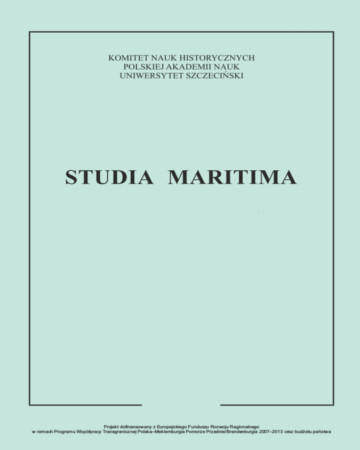






| Authors: |
Rafał
Reichert

Uniwersytet Warszawski |
| Keywords: | Spanish shipbuilding South Baltic region timber supply wood commerce XVIII century |
| Data publikacji całości: | 2020 |
| Page range: | 19 (129-147) |
| 1. | Aragón Ruano, Álvaro. “La historiografía forestal sobre época moderna en el panorama internacional, español y vasco: una revisión bibliográfica”, Vasconia, 37 (2011): 117–140. |
| 2. | Aranda, Gaspar de. El camino del hacha: la selvicultura, industria y sociedad, visión histórica. Madrid: Ministerio de Medio Ambiente, 1999. |
| 3. | Aranda, Gaspar de. La carpintería y la industria naval en el siglo XVIII. Madrid: Instituto de Historia y Cultura Naval, 1999. |
| 4. | Artiñano y Galdácano, Gervasio de. La Arquitectura Naval Española en Madera. Madrid: Oliva de Vilanova, 1920. |
| 5. | Attman, Artur. The Russian and Polish markets in international trade, 1500–1650. Gothenburg: The Institute of Economic History of Gothenburg University, 1973. |
| 6. | Baudot Monroy, María. “Barcos para el rey. Julián de Arriaga, la madera y la construcción naval, (1752–1754)”. In: La Armada española en el siglo XVIII. Ciencia, hombres y barcos. Ed. Manuel-Reyes García Hurtado, 297–328. Madrid: Silex, 2012. |
| 7. | Biernat, Czesław. Statystyka obrotu towarowego Gdańska w latach 1651–1815. Warszawa: Wydawnictwo Naukowe PWN, 1962. |
| 8. | Binerowski, Zbigniew. Gdański przemysł okrętowy od XVII do początku XIX wieku. Gdańsk: Gdańskie Towarzystwo Naukowe, 1964. |
| 9. | Bogucka, Maria. Gdańsk jako ośrodek produkcyjny w XIV–XVII wieku. Warszawa: Wydawnictwo Naukowe PWN, 1962. |
| 10. | Bogucka, Maria. Handel zagraniczny Gdańska w pierwszej połowie XVII wieku. Warszawa–Kraków: Ossolineum–PAN, 1970. |
| 11. | Cieślak, Edmund. Historia budownictwa okrętowego na Wybrzeżu Gdańskim. Gdańsk: Wydawnictwo Morskie, 1972. |
| 12. | Crespo Solana, Ana. “El comercio holandés y la integración de espacios económicos entre Cádiz y el Báltico en tiempos de guerra (1699–1723)”. Investigaciones de Historia Económica, 8 (2007): 45–76. |
| 13. | Crespo Solana, Ana. Entre Cádiz y los Países Bajos: una comunidad mercantil en la ciudad de la Ilustración. Cádiz: Fundación Municipal de Cultura, 2001. |
| 14. | Crespo Solana, Ana. El comercio marítimo entre Ámsterdam y Cádiz (1713–1778). Madrid: Banco de España, 2000. |
| 15. | Davis, Ralph. The Rise of the English Shipping Industry in the Seventeenth and Eighteenth Centuries. London: Macmillan & Co, 1962. |
| 16. | Díaz Ordoñez, Manuel. “La comisión del cáñamo en Granada. Sustituir la dependencia báltica como estrategia defensiva del Imperio español en el siglo XVIII”, Vegueta. Anuario de la Facultad de Geografía e Historia, 16 (2016): 93–123. |
| 17. | Díaz Ordóñez, Manuel. Amarrados al Negocio. Reformismo borbónico y suministro de jarcia para la Armada Real (1675–1751). Madrid: Ministerio de Defensa, 2010. Fedorowicz, Jan. England’s Baltic trade in the early seventeenth century: a study in Anglo-Polish commercial diplomacy. Cambridge: Cambridge University Press, 1980. Gaziński, Radosław. Handel morski Szczecina w latach 1720–1805. Szczecin: Uniwersytet Szczeciński, 2000. |
| 18. | Gierszewski, Stanisław. Statystyka żeglugi Gdańska w latach 1670–1815. Warszawa: PAN, 1963. |
| 19. | Glete, Jan. Navies and Nations: Warships, Navies and State Building in Europe and America, 1500–1860. Stockholm: Almqvist&Wiksell International, 1993. |
| 20. | González Caizán, Cristina, Cezary Taracha, Diego Téllez Alarcia, Cartas desde Varsovia. Correspondencia privada del Conde de Aranda con Ricardo Wall (1760–1762). Lublin: Werset, 2005. |
| 21. | Groth, Andrzej. “Port w Królewcu: jego funkcje i zaplecze w XVI–XVIII wieku”. Słupskie Studia Historyczne, 13 (2007): 199–203. |
| 22. | Groth, Andrzej. Żegluga i handel morski Kłajpedy w latach 1664–1722. Gdańsk: Wydawnictwo Uniwersytetu Gdańskiego, 1996. |
| 23. | Guitián Rivera, Luis. “La destrucción histórico del bosque en Galicia”. Semata. Ciencias Sociais e Humanidades, 13 (2001): 105–166. |
| 24. | Guldon, Zenon. Związki handlowe dóbr magnackich na prawobrzeżnej Ukrainie z Gdańskiem w XVIII wieku. Toruń, Wydawnictwa Uniwersytetu Mikołaja Kopernika, 1966. |
| 25. | Israel, Jonathan. Dutch Primacy in World Trade, 1585–1740. Oxford: Oxford University Press, 1990. |
| 26. | Jezierski, Andrzej, Cecylia Leszczyńska. Historia Gospodarcza Polski. Warszawa: Wydawnictwo Key Text, 2003. |
| 27. | Kazusek, Szymon. Handel zagraniczny Korony w końcu XVIII wieku. Tabele statystyczne. Vol. 1–2. Export i Import w latach 1786–1790. Kielce: Uniwersytet Jana Kochanowskiego, 2013. |
| 28. | Lesiński, Henryk. Handel morski Kołobrzegu w XVII i XVIII wieku. Szczecin: Wydawnictwa Naukowe Wyższej Szkoły Pedagogicznej w Szczecinie, 1982. |
| 29. | Mączak, Antoni. Między Gdańskiem a Sundem: studia nad handlem bałtyckim od połowy XVI do połowy XVII wieku. Warszawa: PWN, 1972. |
| 30. | Martínez González, Alfredo. “Bosques y política naval atlántica: las reformas normativas e institucionales de José Patiño (1717–1736)”. Revista Hispanoamericana, 3 (2013): 1–26. |
| 31. | North, Michael. From the North Sea to the Baltic: Essays in Commercial, Monetary and Agricultural History, 1500–1800. Aldershot: Ashgate, 1996. |
| 32. | Odriozola Oyarbide, Lourdes. La construcción naval en Gipuzkoa, siglo XVIII. San Sebastián: Diputación Foral de Gipuzkoa, 1997. |
| 33. | Olszewski, Krzysztof. The Rise and Decline of the Polish–Lithuanian Commonwealth due to Grain Trade. Venice: Ca‘Foscari University of Venice, 2007. |
| 34. | Reichert, Rafał. “El comercio directo de maderas para la construcción naval española y de otros bienes provenientes de la región del Báltico sur, 1700–1783”. Hispania. Revista Española de Historia, 76–252 (2016): 129–158. |
| 35. | Taracha, Cezary. “Jeszcze o gdańskiej misji Pedra Arandy w 1761 roku”. Rocznik Gdański, 56/2 (1996): 17–21. |
| 36. | Topolski, Jerzy. Gospodarka polska a europejska w XVI–XVIII w. Poznań: Wydawnictwo Poznańskie, 1977. |
| 37. | Torrejón Chaves, Juan. “La madera báltica, Suecia y España (siglo XVIII)”. In: Comercio y Navegación entre España y Suecia (siglos X–XX). Ed. Alberto Ramos Santana, 163–222. Cádiz: Universidad de Cádiz, 2000. |
| 38. | Torres Sánchez, Rafael. “Administración o Asiento. La política estatal de suministros militares en la monarquía española del siglo XVIII”. Studia Historica: Historia Moderna, 35 (2013): 159–199. |
| 39. | Torres Sánchez, Rafael. Military Entrepreneurs and the Spanish Contractor State in the Eighteenth Century. Oxford: Oxford University Press, 2016. |
| 40. | Trzoska, Jerzy. Żegluga, handel i rzemiosło w Gdańsku w drugiej połowie XVII i XVIII wieku. Gdańsk: Uniwersytet Gdański, 1989. |
| 41. | Valdez Bubnov, Iván. Poder naval y modernización del Estado. Política de construcción naval española (siglos XVI–XVIII). México: Universidad Nacional Autónoma de México, 2011. |
| 42. | Wójcicki, Józef. Morze Bałtyckie w historii Polski. Warszawa: Książka i Wiedza, 1989. |